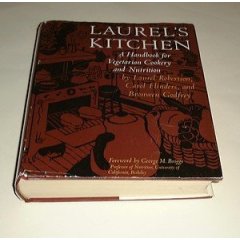Going Vegetarian in the 70s

Although some people might consider the hippie 60s to be the time when many Americans decided to give up, or sharply curtail, their meat consumption, it was during the allegedly vain 70s that the vegetarian movement really started taking off. Maybe it was the disappointment which many of us felt with the larger social movements of the prior decade, which did not create the utopias their originators had hoped for (or at least said they wanted), but for millions of us the switch to a vegetarian diet, along with small environmental moves such as recycling, became sometheing we could do to make the world better - and be healthier at the same time.
Vegetarianism actually has a long history in America, thanks somewhat to leaders such as Dr. John Harvey Kellogg (yeah, as in the cereals), who argued that we could adequately subsist on non-meat diets if we simply balanced our protein sources. Remember Loma Linda brand baby formulas? They were a product of the Adventist movement, and its emphasis upon vegetarianism. In fact, the Loma Linda brand made all sorts of vegetarian products during the 70s, including "Tender Cuts," which were designed to taste like fish, but really resembled, well, Tender Cuts. Vegetable substitutes for meat dishes were pretty primative back then.
Several books made vegetarianism not only a health and humanitarian issue, but one of global survival. Probably the best of these was Diet for a Small Planet, by Frances Moore Lappe (still in print), which stressed the idea of "complimentary proteins. In order to get the requisite essential amino acids, Lappe argued, we need to mix our vegetarian sources so that one food makes up for the defficiencies of another. The results, typically mixtures of legumes and grains, were remarkably close to what rural folks had been doing for hundreds of years (think succatash or rice and beans). Not only was vegetarianism healthy, the author stated, but it could help alleviate hunger. We grow more than enough food to feed the planet, but jpractices such as pumping beef steers full of grain waste an astonishing amount of vegetable protein. How much? Well, consider that it takes 14 pounds of grain protein to produce one pound of meat protein.
Although Diets provided quite a few good recipes, cookbooks for vegetarians also were hot items during the Seventies. Probably the best-known and loved was Laurel's Kitchen, which mixed sophisticated culinary ideas with a zillion nutritional tables and (in restrospect) a rather simplistic view of the role of women at home. Indeed, only a stay-at-home mother would have the time to make some of the stuff Laurel suggested. Oh yes, she should also turn off the radio while cooking, so that she could fully participate in the experience. But maybe I'm being too hard on Laura, who was only echoing what a lot of people were thinking.
The Seventies also saw a one-week national "meat boycott." How successful it was I do not recall, but the cattlemen were not happy with the idea, and for months afterwards we would hear how meat prices had to go up because of the horrible losses they supposedly incurred during one week.
As the 80s rolled in things like ecology and concern for hungry people went out of vogue for a while. Indeed, it seemed like everyone who wanted to get elected president had to talk about cattle ranching, as if this were something most Americans knew anything about (aside from watching Westerns). The meat industry started running ads featuring macho types like James Garner stressing that beef was "Real food for real people."
Labels: vegetarianism
